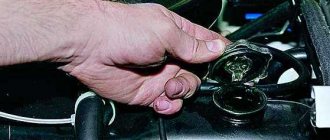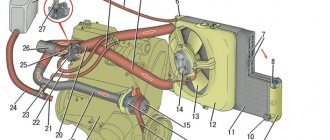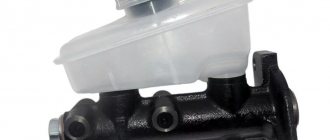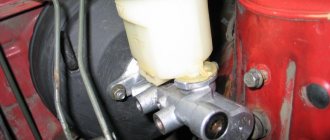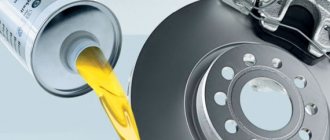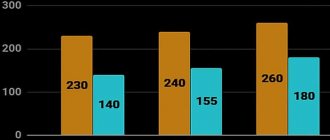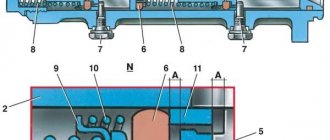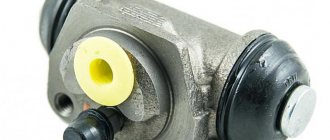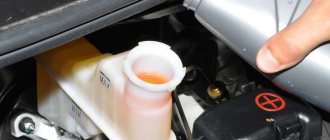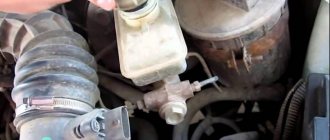Almost from the very appearance of the VAZ 2110, the same defect was often observed in new and old cars - leakage of brake fluid from the master cylinder (GTC), first into the vacuum chamber, and later to the ground:
This was due to the fact that the elasticity of the working and collar cuffs (and even the BRTI) dropped sharply after -23 C, which caused brake fluid to leak from the reservoir and the GTZ. To do this, a channel hole was made on the GTZ to “drain” excess brake fluid from the cavity between the vacuum booster and the main cylinder:
In the photo the cylinder is lying on its side. There was nothing that could be done with rubber bands in the USSR (no such effect was observed on foreign cars), so AvtoVAZ calmed down with this compromise. As the years passed, the GTZ began to fail more often; 90% of them had problems with the collar cuff and the first working chamber. The distant contour was almost always intact. In my practice as a repairman, once on a VAZ 21074 the GTZ suddenly failed completely, upon opening it revealed “cut” cuffs and transparent needle-shaped crystals flowed out of the cylinder with the brake fluid, which cut the cuffs. It turned out that the client mixed brake fluid BSK and Neva. So here is an analysis of the reasons for 90% of the leakage of the “first” cuffs - this is dirt at the end of the gas turbine engine. How did she get there? Very simple - through the drain cut/frost hole.
Problems that arise with the brakes while traveling are considered critical and must be corrected immediately. The culprit of the malfunction is often the main cylinder, installed in the engine compartment and rigidly connected to the pedal. To find out the cause of the breakdown and repair the unit yourself, you need to know the structure of the brake master cylinder (MBC) and its principle of operation. During the diagnostic process, it is necessary to distinguish and filter out problems with other elements of the system.
The rear brake cylinder is leaking, can I drive?
2 ALEX usually this kind of procrastination ends, I
was persuaded, I will change it. I frankly didn’t expect any other answer, the brakes are a serious matter.
the cylinder can be changed in the dark for reference winter -10 22-30 arrived from work, tomorrow at 9 I have to go far because I don’t have a hole and the services are already closed, then with the help of a flashlight, a hammer and 2 keys and WITHOUT A GRAM OF ALCOHOL in the yard at home I changed the cylinders at 2:00 am I finished everything and bled the brakes using a bleeding tool
of the minuses - after 23, the residents were periodically distracted, to which they received philosophical answers, because they usually spoke arm in arm, so I changed 4 front ones, and you need 1 rear one, in a word, don’t put your life and the lives of others more expensive
Well, I’m not at all sure about one cylinder, I just didn’t remove the second drum: I only removed the left one to check the condition of the pads. Or I might as well not look. I wonder if if I hadn’t looked, I would have lived and enjoyed life for the time being. I haven't looked at the front brakes yet either. There is only one sad thing: no one guarantees that the new cylinder will not leak the next day. Shouldn't you remove the drums once a week to check?
As far as working in the dark is concerned, it is certainly possible, but IMHO a cylinder screwed incorrectly in the dark is no better than the current one.
I wonder if I can even change it from the side without a pit or overpass? It seems that everything can be unscrewed there by touch.
Source
Bleeding the brake system after repair
Upon completion of repair work related to the brake system, it is necessary to bleed it. This can be done either independently or by contacting a specialized car service center. Bleeding the brake system is an extremely simple process that every car owner can do, but for this you will need a partner whose task will be to press the brake pedal at the right moment. Even a child can take on the role of a partner.
To bleed the brake system we will need:
- Small capacity;
- Brake fluid;
- A small hose for a fitting.
And so, having found a partner and prepared everything necessary, we bleed the brake system in the following sequence:
- Fill the brake fluid into the reservoir to the “maximum” mark;
- We clean and wipe the brake fittings of each wheel;
- Pour brake fluid into a small container;
- We hook the prepared hose to the fitting;
- We lower the second end of the hose into a container with brake fluid;
- We give a command to our partner so that he begins to press the brake pedal evenly and intensively. After the 4th press, the partner must lock the pedal in the pressed position;
- Lightly unscrew the fitting and watch the brake fluid come out. The presence of bubbles indicates the presence of air in the brake system;
- After the air has escaped, tighten the fitting and repeat this process on all wheels.
Important! Before bleeding the brake system, it is recommended to read the instructions for the car. You should find out in what order the wheels need to be pumped. If this information is not available, you should start from the far wheel to the near one, where the end point is the brake master cylinder. As a rule, pumping begins with the rear wheels, first the right then the left, then we come to the front in the same sequence.
- Leaking brake fluid should be taken extremely seriously, and under no circumstances should you operate a vehicle without it or with a severe leak.
- You should regularly check the brake fluid level yourself, rather than relying on the car's electronics. It is best to do this in conjunction with checking the engine oil.
- After completing repair work, it is imperative to bleed the brake system. It is not allowed to operate a vehicle with unbleeded brakes.
- If one or more elements of the brake system malfunction, they should be completely replaced. This will allow you to avoid unpleasant, and in some cases even dangerous, consequences while driving.
- We also recommend reading the article on our website.
- Brake fluid is leaking: what to do?
- Checking the brake fluid level
- The most common reasons why brake fluid leaks
- How to Fix a Brake Fluid Leak
Any liquid has the ability to flow from one place to another. Brake fluid is no exception; it can leak. But this property of it, like a similar property of any other liquid for technical purposes, is fraught with the fact that some unit may simply fail, or even an accident may occur - a very dangerous phenomenon, especially when traveling on the road .
Checking the brake fluid level
For this seemingly simple reason, every day you need to look under the hood of your car in order to visually check how much brake fluid, antifreeze and engine oil is left in the car. This way you can constantly monitor the amount of brake fluid in the system and thereby protect yourself from an accident on the road.
Along with visual inspection, you need to check the quality composition of this liquid every 6 to 12 months. To do this, you need to purchase a special tester. The frequency with which the check needs to be carried out directly depends on the mode in which the machine is operated.
When inspecting the brake fluid reservoir, you need to carefully look at its side walls. There should be no deposits on them. If they are, and there may also be drops of water or foreign particles, then you will have to completely replace the brake fluid.
The most common reasons why brake fluid leaks
If you have discovered the fact that brake fluid is still leaking from the reservoir, then you need to begin identifying the cause of the leaks. It should be remembered that traces of leakage may not be obvious, that is, not in the same way as engine oil comes out. So, an unreasonable drop in the brake fluid level may indicate that:
The rear wheel brake cylinder is leaking. What to do?
The rear wheel brake cylinder is leaking (leaking) - a malfunction that requires immediate elimination.
Using the example of brake cylinders (wheel brake cylinders) of the rear wheels of the braking system of a VAZ 21093 car, let’s look at the cause of this malfunction and how to fix it yourself.
Symptoms of trouble: the rear wheel brake cylinder is leaking
Brake fluid leaks on the bottom of the brake drum and brake support plate
Noticeable if you inspect the rear wheel from the inside. If you remove the brake drum, everything inside it will be filled with brake fluid.
Leaks under the bleeder fitting and (or) the tip of the tube to the cylinder
After repairing or replacing the brake cylinder, the bleeder fitting and/or the tip of the tube to the brake cylinder were not tightened completely or were tightened misaligned.
Drop in brake fluid level in the reservoir on the master cylinder
You have to constantly add brake fluid.
Reduced braking performance
The brake pedal becomes “wobbly” as the brake drum is lubricated with brake fluid from the cylinder and the pads slide over it. The desired rapid braking does not occur after pressing it.
The handbrake grips the car worse, despite the lever being fully raised.
Causes of the malfunction: the rear wheel brake cylinder is leaking
Worn brake cylinder sealing rings
O-rings are located on the cylinder pistons. They constantly move with them when the car is braking and prevent brake fluid from escaping. Over time, they wear out due to age and, accordingly, depressurization of the cylinder occurs. The brake fluid first just oozes (the cylinder “sweats”), and then it just flows more and more (the cylinder leaks).
The rate of wear is also affected by the quality of the brake fluid (contamination), the condition of the mirror inside the brake cylinder (along which the sealing rings move), the condition of the cylinder boots (dirt can get under them), the degree of wear of the brake pads (if the wear is severe, the pistons are pushed out too far). cylinders, which may cause displacement and rupture of anthers).
Worn brake cylinder mirror
An increase in the roughness of the working surface - the internal mirror (polished coating) of the brake cylinder leads to a violation of the tight fit of the piston sealing rings to it and its depressurization.
Reasons for damage to the mirror: dirt ingress through torn or displaced boots, brake fluid that is contaminated and (or) of poor quality, has not been changed for a long time (absorbed a lot of water, and where there is water, there is corrosion).
Worn or displaced brake cylinder boots
Brake cylinder boots fail due to age-related fatigue wear. They can also move (jump from their seats) after improper installation during repairs, or when their pistons are strongly pulled out of the cylinders due to excessive wear of the brake pads and (or) drums.
Rear wheel brake cylinders and their parts behave unpredictably if the workmanship is poor. In this case, they may fail immediately after they are installed in the brake mechanisms of the rear wheels.
The tip of the tube to the cylinder or the bleeder fitting are not properly tightened
It was loosely tightened during repairs.
What to do if a malfunction occurs: the rear wheel brake cylinder is leaking?
The best option, since a new cylinder is not expensive, changing it is not that difficult, and problems with brake fluid leakage can be avoided for a long time.
Replace o-rings and boots
Such repairs are advisable if the cylinder mirror is in good condition. The repair kit for the rear brake cylinder of a VAZ 21093 car is not very expensive. But installing it is more complex and time-consuming than simply replacing the cylinder with a new one.
Pull the tube tip to the cylinder and (or) the bleeder fitting
We use a special wrench for tightening.
Turn off the rear wheel brake cylinder
There are several ways to plug. Here is the simplest one: disconnect the brake pipe going to the current cylinder of the rear wheel from the main brake cylinder, and in its place screw in a plug (a piece of bent brake pipe with a tip).
After all manipulations with the wheel brake cylinder, it is recommended to bleed the brake system.
Notes and additions
It is recommended to replace the brake fluid in the brake system of the VAZ 21093 with new one every five years. Since it is hygroscopic, it absorbs moisture from the surrounding air. Increased water content causes corrosion of the internal surfaces of the brake cylinders and causes them to leak.
Source
Symptoms of problems
The fluid brake system consists of many parts that can become unusable: pipes, wheel cylinders, calipers, drums and pads. Typical signs of a faulty master cylinder:
- After pressing the pedal, the car stops slowly. The reason is that the cuffs of one or two pistons have lost their tightness - they have cracked or “floated”.
- To slow down, you need to press the brake pedal hard. The phenomenon occurs due to swelling of the rubber of the piston seals.
- The brake pedal travel is too short. The fluid inside the cylinder has nowhere to go because the compensation hole is clogged. Another option is that the passage is blocked by a swollen rubber seal.
- A common symptom is pedal failure, the brakes coming on at the end of the stroke. This indicates complete wear of the cuffs; as a result, liquid penetrates behind the piston and rushes into the expansion tank - the cylinder “bypasses.”
- The pads do not release the brake discs and drums and get very hot when driving. Options: one of the pistons is jammed or the bypass hole is clogged.
The listed symptoms of a GTZ malfunction are similar to malfunctions of other elements. Pedal failure also occurs when a large amount of air enters the tubes or loss of fluid in one of the working cylinders. Sluggish deceleration and increased force on the pedal are often caused by a breakdown of the vacuum booster - a cracked membrane or a lack of tightness at the joints of the hose that takes off engine vacuum.
There are signs that clearly indicate the performance of the main hydraulic cylinder and the malfunction of other elements:
- during braking, the car pulls to the side - the problem lies in a certain circuit or wheel;
- jamming of the brake mechanisms of one wheel;
- creaking and squeaking when braking;
- heating the discs and pads on one wheel.
If you eliminate these symptoms, it will become easier to check the brake master cylinder in a garage. This also includes obvious brake fluid leaks and the knocking sound of worn calipers.
The rear brake cylinder is leaking, can I drive?
- To the beginning of the forum
- Forum Rules
- Old design
- FAQ
- Search
- Users
The other day I discovered that the rear brake cylinder was leaking, I haven’t opened the drum yet, but it’s already clear that everything is in the brake fluid, naturally the pads too. Since the pads are new (I changed them three months ago), the question arose: should I just replace the cylinder and let the pads dry out on their own, or change the pads too (in pairs, of course).
Naturally it is necessary, because the brake pads lose their properties when brake fluid gets on them. I had this happen, at first I only changed the cylinder (for reasons of economy), but soon I had to change the pads as well, as in that saying “the miser pays.” ".
Why bother changing them?
What properties do they lose? I wiped it with gasoline, set it up and drove off.

